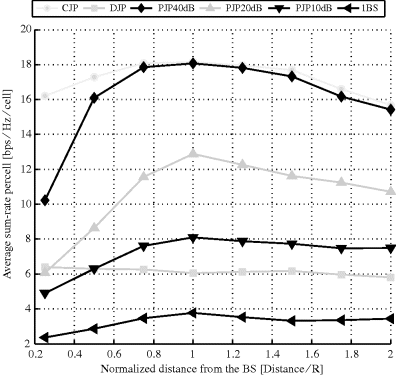Appendix C
Coordinated MultiPoint (CoMP)
C.1 Joint Processing Methods
C.1.1 Partial Joint Processing
In Figure C.1, the average sum-rate per cell obtained by the different transmission schemes is plotted when moving away from one of the Base Stations BSs of the cluster.
Figure C.1 Average sum-rate per cell versus normalized distance for M = 6 UEs and an edge-of-cell SNR of 15 dB (Thiele et al. 2010)

C.1.2 Dynamic Base Station Clustering
In this section, a technique is highlighted in which the Base Station (BS) clusters are created in a dynamic way, that is, in each time slot t the sets of coordinated BSs are generated in order to maximize a given objective function (Boccardi et al. 2008). Such an approach can be seen as an extension of Papadogiannis et al. (2008), with the difference that User Equipments (UEs) and clustering are jointly selected in order to maximize the weighted sum rate.
In order to describe the scheme, let us define ![]() as the set of BS indexes belonging to the nth cluster at the time slot t and
as the set of BS indexes belonging to the nth cluster at the time slot t and ![]() as the set of UE indexes scheduled for transmission in a given cluster at the time slot t. Define and respectively as the BS clustering and UE allocation at the tth time ...
as the set of UE indexes scheduled for transmission in a given cluster at the time slot t. Define and respectively as the BS clustering and UE allocation at the tth time ...

